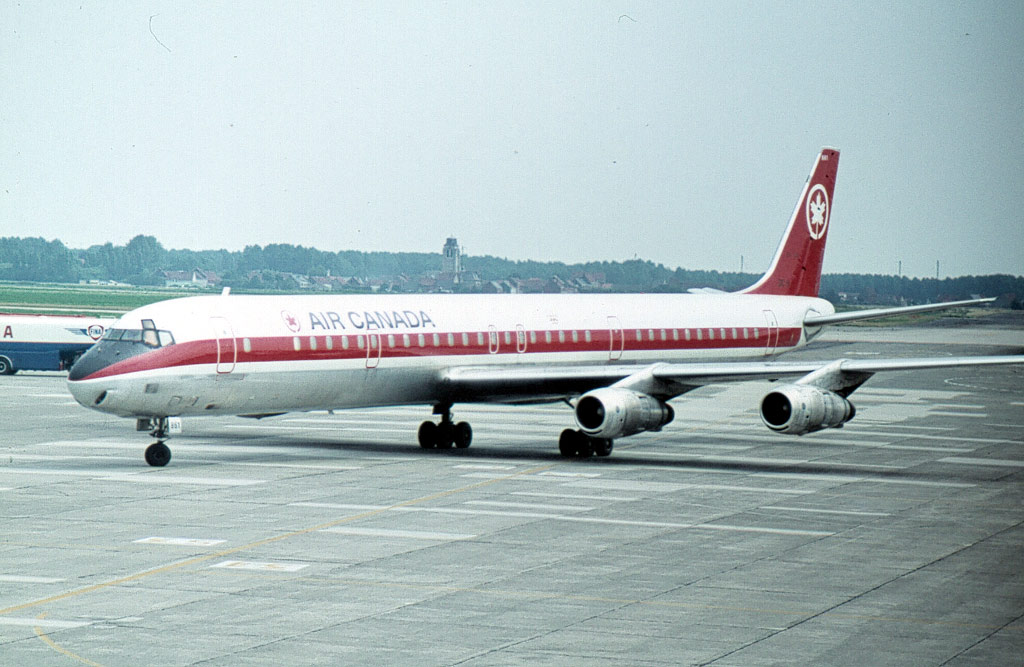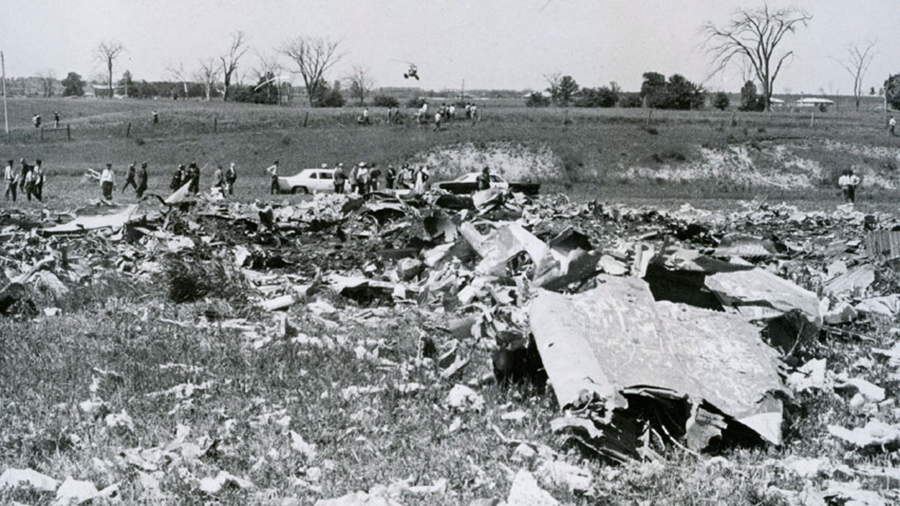5 July 1970 - Air Canada 621
The deadliest accident at Toronto Pearson International Airport took place on July 5, 1970, when Air Canada Flight 621, a Douglas DC-8 registered CF-TIW, was flying on a Montreal-Toronto-Los Angeles route.
Captain Peter Hamilton and First Officer Donald Rowland had flown on various flights together before, and had an ongoing discussion on when to arm the spoilers. They both agreed they did not like arming them at the beginning of the final approach, fearing it could lead to an inadvertent spoiler deployment. The captain preferred arming them on the ground, while the copilot preferred arming them during the flare.
The flare is executed just above the runway, causing the plane's nose to rotate up. That ensures the nose wheel does not contact the runway first, and it also reduces the rate of descent so that the main wheels will not impact the runway too hard. The thrust of the engines is reduced to idle at the same time, causing the speed of the plane to slow significantly.
The pilots made an agreement that, when the captain was piloting the aircraft, the first officer would arm the spoilers on the ground, as the captain preferred, and when the first officer was piloting the aircraft, the captain would arm them on the flare as copilot preferred.

This is a picture of an Air Canada DC-8, similar to the one flown in Air Canada Flight 621. On this particular instance however, the captain was piloting the landing and said, "All right. Give them to me on the flare. I have given up." This was not their usual routine. Sixty feet from the runway, the captain began to reduce power in preparation for the flare and said, "Okay" to the first officer. The first officer immediately armed and deployed the spoilers. The aircraft began to sink heavily and the captain, realising what had happened, pulled back on the control column and applied full throttle to all four engines. The nose lifted, but the aircraft still continued to sink, hitting the runway with enough force that the number four engine and pylon broke off from the wing. Realising what he had done, the first officer began apologizing to the captain. The aircraft eventually managed to lift off for a go-around, but the lost fourth engine had torn off a piece of the lower wing plating and the aircraft was now trailing fuel, which ignited. The first officer requested a second landing attempt on the same runway but was told it was closed due to debris and was directed to another runway.
Two and a half minutes after the initial collision, the outboard section of the right wing above engine number four exploded, causing parts of the wing to break off. Six seconds after this explosion, another explosion occurred in the area of the number three engine, causing the pylon and engine to both break off and fall to the ground in flames. Six and a half seconds after the second explosion, another explosion occurred, destroying most of the right wing, including the wing tip. The aircraft then went into a violent nose dive, striking the ground at a high velocity and killing all 100 passengers and the nine crew members on board.
The mishap was the first Air Canada accident involving fatalities since November, 1963, when another DC-8, Flight 831, also bound from Montreal to Toronto, crashed with a loss of 118 lives. Wreckage, bodies, bits of clothing and women's pocketbooks were strewn for more than 100 yards beyond the impact spot. The plane dug a furrow eight or 10 feet deep, less than 200 feet from a house in which a family of 10 persons lived.
Recovery and identification of bodies proceeded slowly. More than 20 of the passengers were United States citizens, all of them listed as being from Southern California.

Transcript of the Cockpit Voice Recorder (CVR)
| Source | Content |
| FO | Nice day |
| CA | Beautiful |
| FO | That's where old (unintelligible) lives there I guess. What do they call it? High Park? |
| CA | Oh |
| FO | Those apartments there. See them? The high-rise there |
| FO | Yes It looks over the (unintelligible). It's quite a good view out over the lake there. |
| SO | The housing in Toronto is out of this world. Expensive, yeah. |
| FO | Yeah, expensive all right. |
| FO | Yeah, a lot of people have made a lot of money. |
| CA | Yeah, Ill say. |
| CA | Four for three |
| FO | Four for three |
| [click click click] | |
| APP | Air Canda 621 is cleared for the vectored ILS. Take course 32 and turn right to 230 final and four miles |
| RDO-FO | Roger |
| APP | 230 |
| RDO-FO | Roger. 230. |
| APP | You are currently three and a half east of the marker |
| RDO-FO | 621 |
| CA | Before landing |
| [clunk. An increase in background noise] | |
| FO | 2975 |
| APP | 621 right turn now to heading 28. You are three to the marker |
| FO | Check three green. Four pressures. Spoilers. |
| FO | No (unintelligible) on the green |
| CA | All right. Give them to me on the flare. I have given up. |
| FO | (laughing) |
| CA | I am tired of fighting it. |
| SO | Fuel (panel) set |
| CA | Thank you |
| CA | Thirty-five flap |
| FO | Thirty-five |
| FO | 142 |
| APP | Air Canada 621 right around to 310 to intercept the back course. Turn into 187. Good day |
| RDO-FO | Maintain 310 (roger). Goodday |
| RDO-FO | Toronto tower. Air Canada 621. Approaching the whisky |
| TWR | 621 stil depart to 727 |
| [apparent power increase] | |
| FO | Well it's pretty late |
| CA | Yeah |
| FO | Surprise (unintelligible) |
| CA | Landing flap |
| FO | 129 |
| CA | 134 5 |
| [apparent power decrease] | |
| RDO-FO | 621 is by the whisky |
| TWR | 621 roger. Check (your) gear down |
| FO | Gear down |
| SO | Spoilers to go in the (unintelligible) |
| CA | Okay, thanks |
| [apparent power increase] | |
| [whistling] | |
| CA | Ho Ho Ho |
| CA | Well that's right on the VASIS. We are little below the glide though |
| FO | Yeah you are right |
| CA | It's going to be rougher than a gut. Look at that stuff laying there on the runway |
| [apparent power decrease] | |
| FO | Get that thing off the ground. He is leaving a smoke screen for you, just to make it a little challenging |
| TWR | 621 cleared to land on runway 32 |
| RDO-FO | 621 |
| CA | My IFR approach here unknown. Heh, heh, heh |
| FO | Here we have a green. The VASIS appear to be a little bit high but you are low on the glide path |
| FO | Takes a whole airfield that way |
| CA | Yeah |
| CA | Okay |
| [apparent power reduction] | |
| CA | No. No. No |
| FO | Sorry, of sorry, Pete! |
| [apparent power increase] | |
| [noise of impact] | |
| FO | Sorry Pete! |
| CA | Okay |
| CA | We have lost our power |
| [exclamation] | |
| TWR | Air Canada 621. Check you on the overshoot and you can contact departure on 199 or do you wish to come in for a mile on 5 right |
| CA | We'll go around. I think we are all right |
| RDO FO | Roger. We are go all the way (around) |
| TWR | Okay contact departure |
| FO | Roger 199 |
| CA | Get the gear up please, Don |
| [sound of horn] | |
| FO | What about the flap |
| CA | Flap 25 |
| FO | Sorry. What was (unintelligible) |
| SO | Number 4 generator is gone |
| CA | Okay, get the cross-feed off first (though). Good (unintelligible) |
| CA | Will you give the approach a call? |
| [Sound of middle marker signal] | |
| RDO-FO | Toronto Approach Control. Air Canada 621 is overshooting on 32. |
| DEP | Air Canada 621 confirm on the overhoot |
| RDO-FO | Affirmative |
| DEP | Okay, sir. Your intentions please. |
| RDO-FO | Roger. We would like to circle back for anothr attempt on 32. |
| DEP | Okay. Runway is closed. Debris on the runway. Twenty three left - it is probably about the best. The wind is northwest about 10 to 15. Turn right heading 070 3000 feet. |
| RDO-FO | Right 070 roger 3000 |
| DEP | Roger 621 |
| CA | We've lost number 4 engine |
| FO | Have we? |
| CA | (unintelligible) |
| SO | Fuel |
| SO | Fuel |
| CA | Aye? |
| SO | Fuel |
| CA | Is it? |
| FO | Yes |
| CA | Okay, cut number 4 |
| ?O | Number 4 engine |
| CA | Yes |
| ?O | Number 3 engine |
| CA | Number 4 |
| ?O | Number 4, right. |
| CA | Number 3 is jammed, too |
| FO | Is it? |
| CA | There it is. |
| CA | The whole thing is jammed. |
| [crackling noise] | |
| FO | What was that? |
| FO | What happened there, Peter? |
| CA | That't number 4 (unintelligible) Something's happened (unintelligible) |
| FO | Oh, look, we've got a (unintelligible). |
| [loud sound of explosion] | |
| FO | Pete, sorry. |
| [louder sound of explosion] | |
| CA | All right. |
| DEP | 621. The status of your aircraft, please. |
| [sound of metal tearing] | |
| CA | We've got an explosion |
| FO | Oh look, we've got (unintelligible) flame |
| FO | Oh, gosh |
| ?? | We've lost a wing |
| [end of transcript] |

